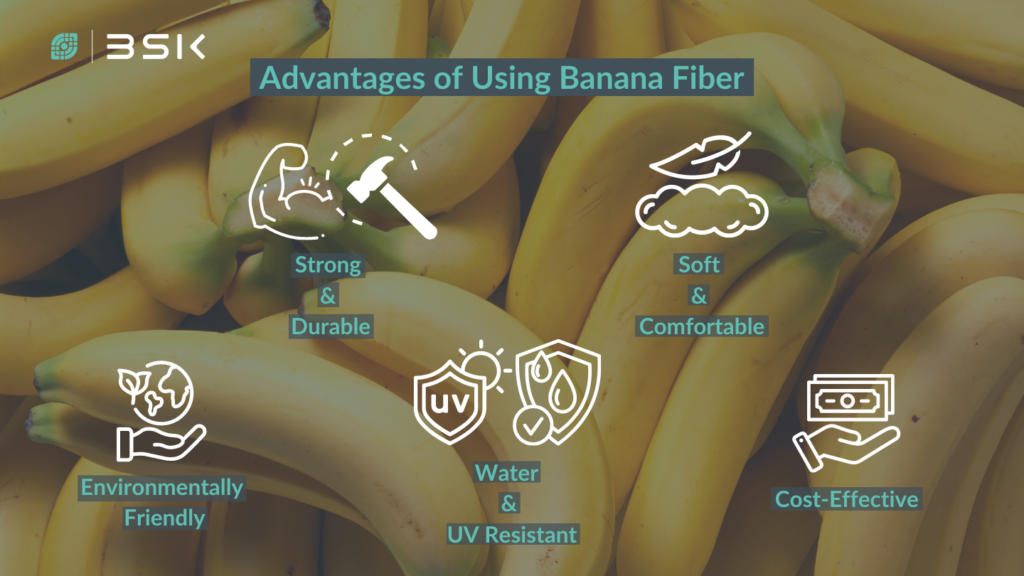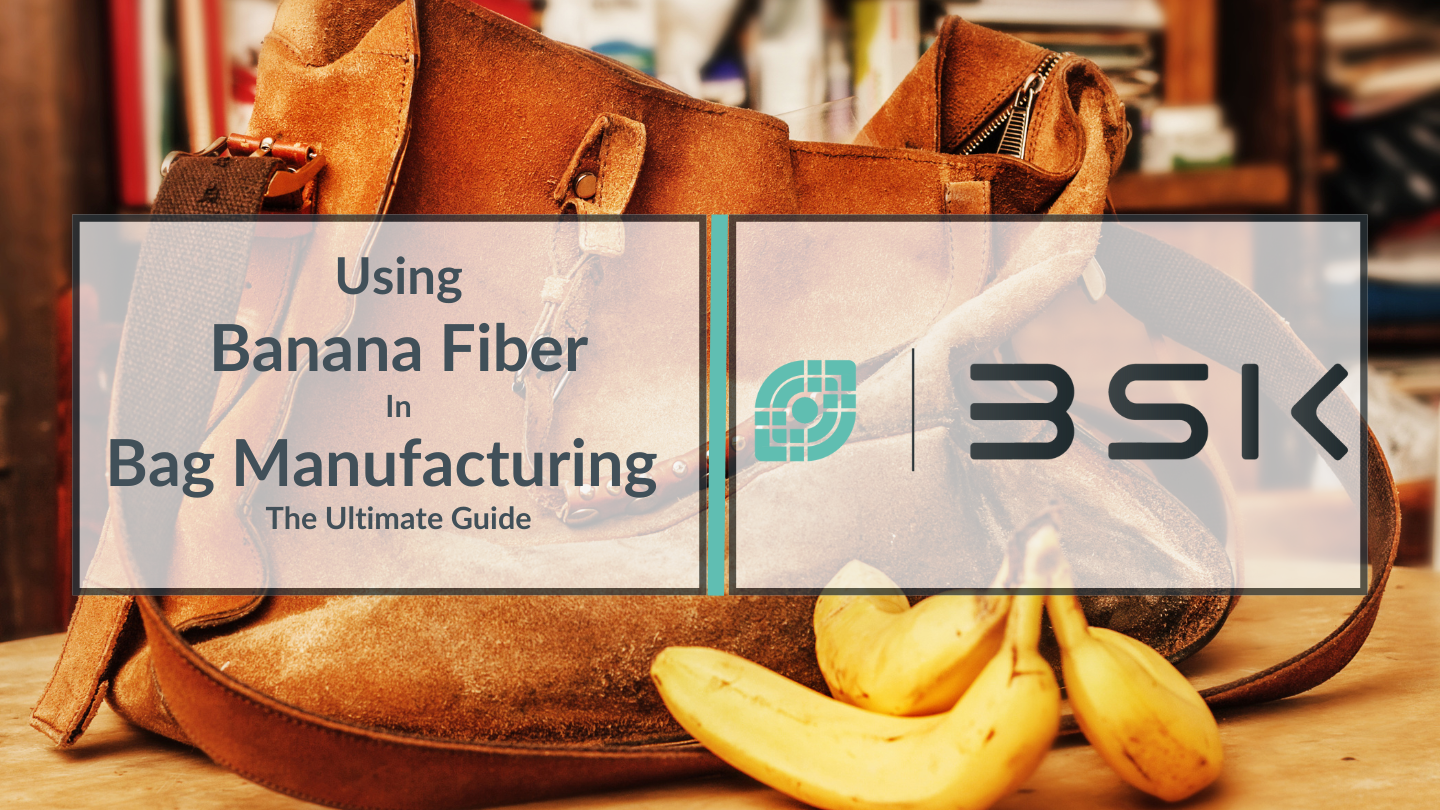Using banana fiber in bags isn’t just a bunch of fluff—it’s a real peel possibility. Choosing the right materials is no monkey business when developing and producing bags. It’s crucial. The material directly affects the bag’s durability—ensuring it doesn’t split under pressure, functionality—so you’re not slipping up on usability and appearance—because who doesn’t want their bag to a-peel to the eye?
A well-chosen material can ensure the bag can withstand daily use, protect its contents, and maintain its bunch-worthy look over time. The material selection process is crucial for bags due to varying strength, weight, and environmental resistance needs. After all, we’re not just talking about making a banana skin here. Additionally, it’s important to consider environmental and ethical factors when choosing materials, not just the physical characteristics of the bag—because the last thing we want is for our eco-friendly efforts to slip on a banana peel.
Choosing eco-friendly materials can appeal to environmentally conscious consumers and enhance a brand’s reputation for responsible production practices. Exploring innovative and sustainable materials like banana fiber, known for its eco-friendly qualities and versatility, is especially relevant. It advances sustainability in the textile and fashion industries and creates practical, ethical bags.
The Diverse Applications of Banana Fiber
Banana fiber, or banana silk, is an eco-friendly natural fiber used in the textile industry as a sustainable alternative to synthetics. It is derived from the banana plant’s stems, reducing agricultural waste. Banana fiber is celebrated for its exceptional strength, durability, and natural softness, offering a comfortable wear experience. It is environmentally friendly, biodegradable, and can be produced relatively cheaply. Moreover, it possesses water and UV resistance, amplifying its appeal for various applications. In bag manufacturing, banana fiber’s robustness and durability make it an excellent choice for producing durable, eco-friendly bags. Its unique texture adds an aesthetic value, ensuring the bags are practical and stylish. Manufacturers can use banana fiber to create a range of products, tapping into the increasing demand for sustainable fashion options. Its versatility extends to non-woven products and industrial applications, showcasing the potential to replace more resource-intensive materials.

Using Banana Fiber: A Sustainable Innovation
Advantages of Banana Fiber for Bag Production
- Strong and Durable: Banana fiber’s impressive strength and durability make it ideal for bags that are used daily. Its ability to withstand wear and tear ensures that the bags carry significant weight without breaking. This resilience is perfect for creating shopping or tote bags that are both sturdy and reliable.
- Soft and Comfortable: Banana fiber is smooth despite its strength. Banana fiber bags offer a unique blend of durability and softness, transforming them from practical items into luxurious, comfortable commodities.
- Environmentally Friendly: Banana fiber is eco-friendly as a renewable and biodegradable material. This characteristic aligns with the growing consumer demand for sustainable products that reduce environmental impact.
- Water and UV Resistant: Banana fiber is water and UV-resistant, ideal for outdoor and all-weather bags. This feature ensures the longevity of beach bags and travel backpacks, protecting the contents and maintaining the bag’s color integrity.
- Cost-Effective: The abundance and accessibility of banana fiber make it a low-cost production material. The affordability of banana fiber bags allows for competitive pricing, making them appealing as high-quality, eco-friendly, and reasonably priced products.
Limitations and Challenges
Durability: Banana fiber may not be as durable as conventional materials, potentially resulting in a shorter lifespan for bags made entirely from it, especially under significant wear and tear.
Production Cost: More expensive due to the labor-intensive process of extracting and processing the fiber, potentially raising the final cost of banana fiber bags and limiting its marketability.
Moisture absorption: Lower moisture absorption capability might hinder performance in rainy or high-humidity conditions.
Color Limitations: The natural color might not suit everyone’s taste, and the ability to dye it into a wide range of colors may be limited, restricting design options.
To effectively use banana fiber in manufacturing, it is recommended to blend with other fibers to improve durability and decrease costs. Developing advanced processing techniques for efficiency, establishing steady supply networks, and targeting niche markets that prioritize sustainability are also important. Alternative materials such as hemp or bamboo fibers could also provide similar environmental advantages. By addressing these challenges, manufacturers can successfully incorporate banana fiber into eco-friendly products, appealing to a broader audience.
Manufacturing and Production Considerations
In working with banana fiber, specifically within the context of its production and manufacturing for use in bags and similar textiles, unique considerations come into play.
Manufacturing Processes
Manufacturing involves extracting fiber from banana plants’ stems to agricultural waste. The process is labor-intensive, given the need to manually separate the fibrous material from the plant. Despite this eco-friendly nature and sustainability make it an appealing material. Once extracted, the fibers undergo processing, which includes washing, drying, and combing, before spinning them into yarn.
Special Equipment or Techniques
Specialized equipment and techniques are often required to process banana fiber due to its natural and somewhat delicate nature.
Fiber Extraction Equipment: Specialized decorticating machines help separate the fibers from the plant stems more efficiently, although manual extraction is still common.
Spinning and Twisting Machines
To turn the fibers into usable yarn, appropriate spinning, and twisting machines adapted for banana fiber’s unique properties are necessary.
Strength Consideration
Given its strength and durability, banana fiber is suitable for creating products that require resilience. However, designers should consider double or reinforced stitching for items subjected to heavy use.
Moisture and UV Resistance
These natural properties allow versatility when designing products intended for outdoor use. However, its water resistance also demands careful consideration in dyeing and coloring processes, as the fiber may absorb dyes more slowly than conventional materials.
Softness and Texture Variation:
The fabric’s natural softness and texture vary, influencing the product’s final feel and appearance. This leads to a need for careful selection of banana fiber batches to ensure product consistency, especially in larger production runs.
Limited Color Options:
Designers may need to plan color schemes around natural hues or use sustainable dyeing methods that are effective.
Overall, creating bags and textiles requires a nuanced approach, balancing the material’s unique ecological benefits with the practicalities of its production and processing techniques. This balance allows for creating sustainable, durable, and eco-friendly fashion items that leverage banana fiber’s distinctive properties.
Sustainability and Environmental Impact
Valued for its eco-friendly qualities that contribute to sustainability in the textile industry. Producers derive it from the stems of banana plants, turning agricultural waste into a valuable resource and reducing waste. This innovative use of banana stems leverages a renewable resource. It supports the plant’s ability to grow back each year after harvesting, emphasizing its role as a sustainable material. The environmental benefits are manifold. It is both renewable and biodegradable, naturally decomposing over time and reducing waste in landfills.
Banana fiber production aligns with efforts to minimize carbon footprints through natural and sustainable methods. Despite not mentioning certifications or industry standards, the material’s properties and production process strongly align with eco-friendly practices. Textiles support broader environmental concerns and trends, particularly the growing demand for sustainable and responsibly sourced materials. Its low cost, abundance, and resistance to water and UV rays make it an appealing, environmentally friendly choice. Banana fiber offers a sustainable fashion alternative, emphasizing ecological benefits and reduced environmental impact.
Conclusion
In conclusion, banana fiber—banana silk—marks a vital shift towards sustainability, benefiting the environment and manufacturers alike. Its eco-friendly nature shines, offering strength, durability, softness, and comfort, plus it’s renewable and biodegradable. Moreover, it possesses water and UV resistance properties, making it versatile for various applications, from textiles to industrial products. However, the journey toward widespread adoption of this fiber is challenging. Extraction and processing labor, availability limits, moisture issues, and limited color options require urgent solutions.
Banana fiber is a compelling option for those seeking sustainable materials in the bag manufacturing sector. It uniquely combines durability, environmental benefits, and aesthetic appeal, aligning with the growing consumer demand for eco-friendly products. While weighing the material’s advantages against disadvantages is important, this offers a path toward more sustainable manufacturing practices. Embracing sustainable materials, banana fiber shines for eco-friendly fashion, innovating bags to meet sustainability goals and push design boundaries.

Is banana leaves or banana silk use for making clothes too if its yes then how and is durability is good or bad.
But it somewhere more expensive to.